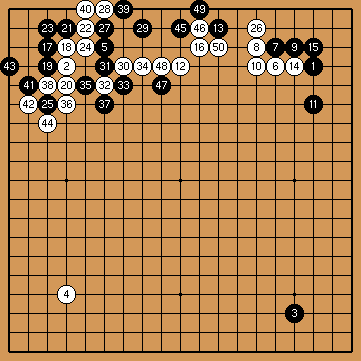
Click the icon to use the online replay facility to progress
the game move by move.
Fig 1

After the game Lee was playing around with some stones
and put dia 1 on the board, for a
moment he seemed to like it better than the game but
soon he cleared away the stones and probingly played
directly at 7 instead of black1. This, however also did
not seem much to his liking. Hane Naoki 9p mentioned
that because of a black stone at the 6-3 point he would
never play the attachment of black 7 in the game since
that seems to force white to develop the upper part of
the board, something he wanted to do anyway!
Black 13 is a probe, and not as outrageous as it looks
like. The thing is, playing this move so early on in
the game it is totally unclear whether it will come out
nicely or not. In this game Chang Hao did not seem to be
bothered by 13 much and in the end Lee himself admitted
the move seemingly had not given him any advantage
(compared to directly entering the upper left corner).
White 30 sets up a fierce attack. Hane Naoki was asked
by one of the about 120 people gathered to watch his
commentary if white was trying to kill the black stones
at the top. "Certainly not, stones like that are not
something to go after. However, white will try to keep
the pressure on as long as possible (as long as it takes
for white to get a result he can feel satisfied with).
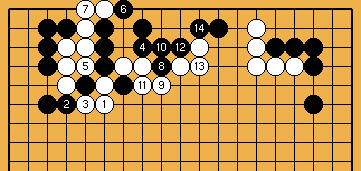
Instead of white 36 to play as shown in dia
2 was possible too according to Hane. "It's
white's choice so Chang Hao obviously judged that
dia 2 was not as good for white as the
game". By the way, black at 12 is the correct order,
playing this move directly at 14 will leave a shape
which somewhere along the line might be attacked and
find itself without eyes.
After the game Chang Hao
commented that the moment white got to take the black
stone when playing 44 he felt he was doing ok, not
winning or something, just doing ok. Black 49 caused
some consternation :-) Pro's of all countries present
went simultaneously "What, is he serious?!" The only
justification for black 49 would be to aim at attacking
the whole chain of white stones. For your average
amateur this is a totally normal way of looking at
the game for the pro's, however, it felt like black
was overdoing things. Perhaps black felt that he was
slipping behind a little and had to catch up somehow.

Fig 2
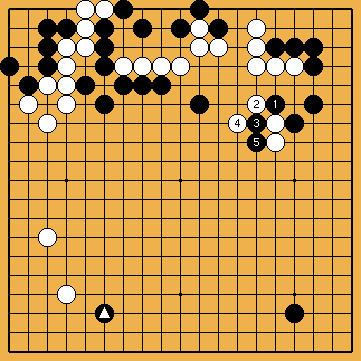
Black 57 is a "oh so innocent" looking move but if you
do not realize in time that black is aiming at the
sequence shown in dia 3 you will find
yourself behind before you know it. Also because of
this ladder-threat Chang Hao was not happy with white
54. Chang regretted this move a lot. Right after the
game he took this stone and moved it one space to the
left a couple of times with a grim grin on his face
suggesting that he had difficulty recalling why exactly
he had played the move in the game (the drawback of the
game move is that black 133 will sooner or later be an
excellent cutting-points-creating move).

Chang Hao also was not happy afterwards with his move
at 68. Lee Sedol suggested that either white blocks as
shown in dia 4 or he plays elsewhere (tenuki). It took
some time to get the translation through but when it was
clear Chang agreed with Lee wholeheartedly.
The game had its swings, now black felt a little better
than white felt ahead. No clear advantages were obtained
by either player but the whole game seems to have been
working up to black 77. This is as crucial a point in
a game as they come. Some might feel that black is
doing fine (I did) but according to the pro's it is
next to impossible to say how and what. (remember, I am
writing this 2 hours after the game finished, some deep
analyzing might prove this or that but even that seems
doubtful owing to the complexity of the situation).
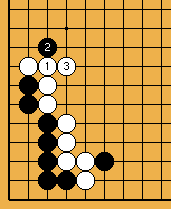
To go back a little, white 72 shows that he is confident
in the strength of the white stones at the upper
left side. Looking at the situation from a different
perspective, suppose white had played after white
connects at 1 in dia 5 the exchange black2-white 3 is
very bad for white provided black can start something
with the help of black 2 at the left side. If not white
3 is fine. To simplify things even further, when playing
game move 72 white made a statement "there is nothing
at the left side, go away, leave me alone". Next it is
black who makes a statement with 73 and 77 "O yeah? Well
I'm telling you, you better start patching up things or
else..."
To yet put it in still other words, up to this point the
game was like two gun fighters circling each other end
trying to get an advantage, trying to make the other
face the sun. Finally the circling is done with and
somebody has to draw first.
White 78 or thereabouts is the only move. Chang Hao
"can't defend at the left, white does not have enough
territory yet". Black 79 is probably the move which cost
Lee the game. The pro's gathered did some deep analyzing
here and to cut a long story short: after black 79 if
he has no severe follow-up sequence to make it hard on
white he shouldn't have played there in the first place.
Lee Sedol himself very much seemed to have felt that way
already (he came to that conclusion about 10 times as
fast as the other pro's). He didn't speak so much during
the after-game analyzing but now through the interpreted
he said "and what do you do if I play here?

Dia 6 is the
move Lee meant, the quiet diagonal move at 1.
Supposedly dia 6 shows the best move for black, Lee
very much seemed to have thought about it during the
game but perhaps he felt it just wasn't enough. Chang
Hao answered Lee's question "same story, white cannot
answer at the left even though it might prove dangerous
to ignore black (1) white just doesn't have enough
territory to play passively yet".
Hearing this Lee slumped in his chair, Chang's answer
makes it clear that compared to the game move black 1
would have been better, it leaves black less thin and
gives him ample opportunity to start a harsh offensive
towards the upper left white guys.
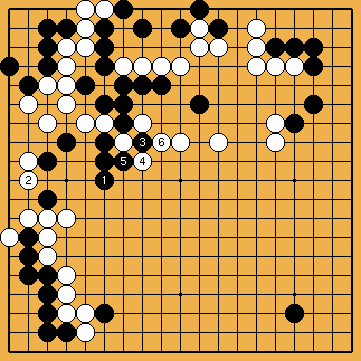
At this point of the game just before the play was
interrupted for lunch the general consensus was that Lee
Sedol would win and could take home the Toyota-Denso cup
and a nice car, too. Black 89, however, just wasn't the
right move here but it was not possible for the pro's
to find out what black should have done exactly. So
here, finally, the reason is found why black 79 perhaps
was not the proper move. The pro's very much seemed to
expect that no matter how much analyzing they would do
they won't find a nice black move because there isn't
one to be found :-)
To go through everything which appeared on the board
while coming to this conclusion would take much more
time and energy I have at the moment (besides, I'll
probably get something wrong, there were just so many
stones appearing on the board as magic and disappearing
even faster for some 10 minutes). It seems that black
could have attacked the white left group by setting up
a ko but that there were no sufficient threats yet.
Another thing which I seem to remember is the move shown
in dia 7. This seems to make a black play at 2 or 3 of
the same value. However, besides the pro's analyzing in
the press room, Lee himself put this on the board in
the after game pow-wow and showed a face for which no
interpreter was needed. He didn't like it if white would
just let one stone be captured as in the diagram and black
would eventually find himself forced to connect at the
left of three. Even than, however, the black group is
still not alive.
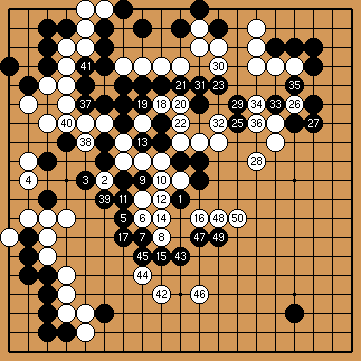
Fig 3
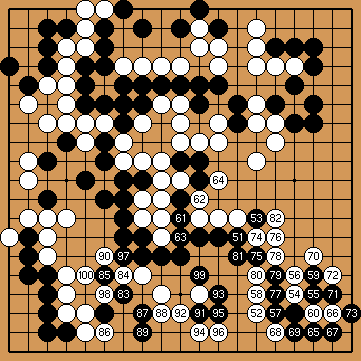
Fig 4
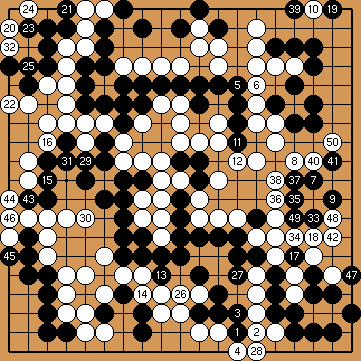
Fig 5
Although one of the pro's of the Korean delegation every
now and then was putting a black stone at 206 and said
something which I unfortunately could not understand
there is nothing left for black to aim at and stage an
upset. For a moment it might look as if black could
start a desperate kind of ko when he (somewhere after
white 136) wedges at 206. However, if black separates
there, white simply play at the point above 205, forcing
black to connect (at 205). White can then atari on the
2nd line and easily make two eyes on the top side. There
is no ko fighting. Towards the end of the game the
spirits of the Korean team sunk a notch or two. Although
I'm looking forward to the next and final game it seems
safe to assume that the almost palatable tension in
the pressroom will even increase more. It is hard to
imagine what kind of pressure the finalists are facing
themselves!
| 












